Steveston, British Columbia
Steveston was originally a small town founded in 1880 by William Herbert Steves [1] near Vancouver, British Columbia. It has since been absorbed into the city of Richmond, British Columbia.
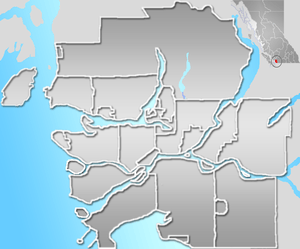
Steveston village is a historic salmon canning centre at the mouth of the South Arm of the Fraser River, on the southwest tip of Lulu Island in Richmond, British Columbia. Since 1945 it has hosted an annual Steveston Salmon Festival on July 1, Canada Day.
The most southwestern tip of this southwestern suburb contains Garry Point Park, the site of the Steveston Fisherman's Memorial.
History
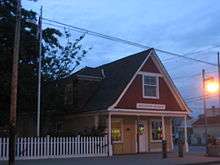
Beginnings
The village is named for Manoah Steves, who arrived with his family around 1877-1878 from Moncton, New Brunswick via Chatham, Ontario. Born Manoah Steeves, a second cousin of William Steeves, he dropped the second 'e' en route. Manoah and his family were the first white family to settle in the area.[2] Steves' son William Herbert actually developed the townsite, which became Steveston in 1889. Salmon canning began on the river in 1871, with the first major cannery being the Phoenix, developed in 1882 by Marshall English and Samuel Martin;[2] by the 1890s there were 45 canneries, about half at Steveston. Salmon-canning was so much part of the life of Steveston that it was also known as Salmonopolis.[3]
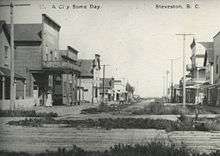
Each summer large numbers of Japanese, Chinese, First Nations, and European fishermen and cannery workers descended on the village, joining a growing year-round settlement. The fishery also supported a significant boatbuilding and shipbuilding industry. Sailing ships from around the world visited the harbour to take on cargoes of canned salmon.
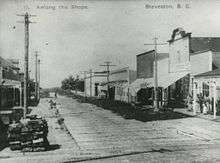
The peak of civic aspirations was pre-World War I, when Steveston was promoted as Salmonopolis, a supposed rival of Vancouver, but canning activity slowly declined and finally ceased in the 1990s. The Gulf of Georgia Cannery, built in 1894 and at one time the largest plant in British Columbia, was reopened as a National Historic Site of Canada in 1994, and remains open today, recently given an award for Canada's best historic site.
The post office, which is also now The Steveston Museum, was once the location of a branch of the Royal Bank of Canada, until it moved in the late 1970s to its current location across the street.
Steveston's Japanese Canadians
Japanese Canadians formed a large part of Steveston's population; their internment during World War II was a serious blow to the community, though some of the internees returned when they were allowed and a sizable Japanese Canadian community still exists. For example, a Japanese judo and martial arts centre was developed in Steveston after the internment.
During World War II, the Department of Transport facility monitored German and Japanese (Kana code) submarine traffic. The facility closed in 1945.
In 1954, BC Packers manager Ken Fraser donated a lot to Steveston's Japanese Canadian fishermen for the purposes of building a joint community centre (which eventually became the Steveston Community Centre); the terms of the agreement also stated that the Japanese Fishermen Benevolent Association be allowed to have a judo room at the centre.[2]
In 1969, community discussion led to the development of a Japanese-style martial arts building for Steveston. The martial arts centre, now a Steveston landmark, is currently located adjacent to the Steveston Community Centre.
Present-day Steveston
Post-war Steveston developed along with Richmond into a residential suburb for Vancouver as farmland was converted to housing. Since the 1970s the community, which remains an active fishing port, has developed its heritage character and its waterfront to attract business and tourism.
Garry Point Park is the major park in Steveston, located at the southwest tip of the community (and Lulu Island). The point of land was named in 1827 to honour Nicholas Garry, former Deputy Governor of the Hudson's Bay Company, who used that part of the land to locate the navigable entrance to the Fraser River.[2] Garry Point Park was the major host location for the Vancouver-area festivities of the 2002 Tall Ships Challenge.
Steveston has often been the site of filming for both films and television shows . It was used in the 2010 film adaptation of The Death and Life of Charlie St. Cloud as a stand-in for Marblehead, Massachusetts, and the television movie A Cooler Climate as the fictional Steveston, Maine. It has been used as a location for The X-Files series, in the episodes "Gender Bender as Steveston, Massachusetts, and later in "Miracle Man." It was also featured on Highlander: The Series as Steveston, Washington, and in the Stargate SG-1 episode "Nightwalkers" as Steveston, Oregon. An episode of the second season of Sliders was shot there, and part of an episode of CW's Supernatural was also filmed in the village. Steveston, particularly storefronts and business along Moncton Street east of the Cannery, transforms into the fictional Maine town of Storybrooke for the hit television series Once Upon A Time.

Tourism
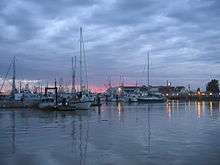
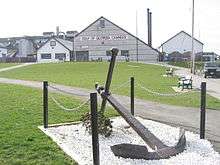
Today, Steveston still maintains the character of a quaint, historic fishing village, with over 600 fishing boats––Canada's largest fleet[4] calling Steveston Harbour home. Over the years, due to its still active fishing fleet, historic buildings, and National Historic Site, The Gulf of Georgia Cannery, Steveston is still very much a small fishing village, though changing quickly. It boasts over 350 businesses and services to accommodate its growing population. Steveston has become a popular place to visit and live. On sunny days, visitors flock to Steveston's waterfront boardwalks to enjoy the scenery, people and food.
In 2002, Steveston hosted a Tall Ships festival, and approximately 400,000 people came to see hundreds of restored sailing ships dock along the coastline. While the event was a spectacular attraction for families, it was a financial flop, and it received strong criticism from Richmond City Council.
Recently, Steveston has also become known as "The Gateway to the Orca," referring to the very active whale watching industry calling Steveston Harbour home. Shuttling boatloads of tourists and locals out to the Gulf of Georgia to observe orca (killer whales), seals, eagles and more.
Steveston Salmon Festival
On Canada Day, Richmond has an annual festival in Steveston called the Steveston Salmon Festival which has been held annually since 1945. This event includes a parade, and a huge barbecued salmon sale beside the Steveston Community Centre. Locally based municipal, provincial and federal politicians frequently show up at this event, usually as part of the parade and/or to hand out Canadian flags.
Popular culture
- Steveston is the setting of Canadian playwright Morris Panych's 2003 Governor General's Award winning play, Girl in the Goldfish Bowl.
- Steveston is portrayed as the fictional town of Chance Harbor in the TV series "The Secret Circle". Moncton Street is seen in the pilot episode.
- Steveston is a major filming location for the American TV series Once Upon a Time, in which it portrays the fictional town of Storybrooke, Maine, with Moncton Street the primary filming site.
- Other TV series filmed in Steveston include the Stargate SG-1 sixth-season episode "Nightwalkers"; The X-Files episode "Gender Bender"; and The 4400 first-season episode "Becoming".
- The 2014 remake of Godzilla was also partially filmed in Steveston, including some of the same street locations used by Once Upon a Time.[5]
See also
- List of canneries in British Columbia
- List of World War II-era fortifications on the British Columbia Coast
References
External links
Coordinates: 49°07′39″N 123°10′53″W / 49.12750°N 123.18139°W

